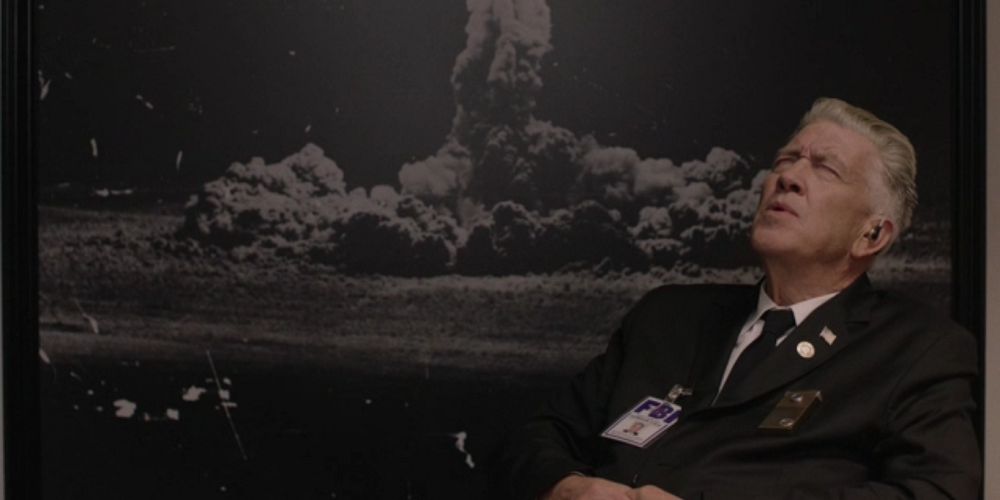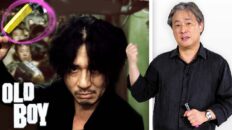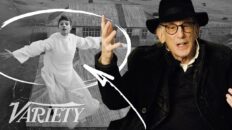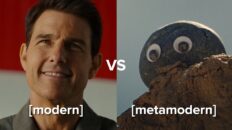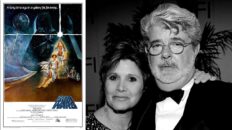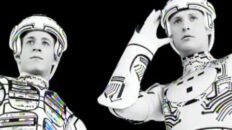“Fix [your] hearts or die.” — David Lynch as FBI Deputy Director Gordon Cole, Twin Peaks: The Return
Toxic ideas. Toxic masculinity. Toxic relationships. Toxic people. Whether it manifests itself through conversations and ideas or actions, the word “toxic” as a descriptor has become a kind of catch-all phrase used to describe a spirit of harm, often coupled with mental and emotional abuse, sometimes with physical violence. To state more plainly than should be needed, this phrase is used in conversation as a metaphor to convey the seriousness of the damage inflicted upon others by those searching to make their positions and feelings understood. But as is often the case in conversation, whether orally and in person or written, any metaphorical device tends to be misunderstood or misused as a literal description.
In episode three of Twin Peaks: The Return, David Lynch doesn’t side step any possible confusion over the idea of toxicity, he steps directly into it, portraying the spirit of BOB – an entity of malice who inhabits? possesses? individuals – as literally toxic, poisoning a highway patrolman who comes across the vile vomit of Agent Dale Cooper’s (Kyle MacLachlan) doppelgänger who has crashed his car while escaping being drawn back into the Black Lodge. BOB has possessed Agent Cooper’s doppelgänger and has been living in this simulacrum for 25 years in the “real world,” since the end of the original Twin Peaks series as Agent Cooper has been stuck in the Red Room of the Black Lodge.
If that seems at all hard to follow, it is. If you haven’t seen, or at least are familiar with story of the original Twin Peaks television series and its prequel film, Twin Peaks: Fire Walk with Me, you won’t easily be able to jump into Twin Peaks: The Return nor be able to make much sense of the plot. In fact, even if you are familiar with what has come before, you might find yourself hard pressed to keep up with what follows. At the same time, the specific intricacies of the plot serve not so much as a linear narrative as linked scenes, which taken together form the story; more abstract, or dreamlike than centered around causality. The Man from Another Place, also known as The Arm, from the original series, for instance, is now a talking tree. Why? Is there some greater meaning or symbolism in this? Or is there some sequence of events that make this evolution make causal linear sense? Or is the talking organic mass on top of the tree “just a head” as Lynch called it?
This juxtaposition of The Arm’s symbol-less metaphor and the literal symbolism of BOB’s toxic regurgitation as Agent Cooper’s doppelgänger is a fundamental element of what Lynch is doing with Twin Peaks: The Revival and indeed much of his work. It is also a key response – a mirror, if you will, reversing front to back, maybe rightly – to cultural confusion surrounding storytelling and listening (storytelling is fluid, not rigid and listening is active, not passive). If that feels as hard to follow as the series’ plot, maybe looking at some specific elements of the series will illuminate the idea.
***
Toxic Ideas — “The Past Dictates the Future”
“The best predictor of future behavior is past behavior” — Mark Twain, or maybe B.F. Skinner, or possibly Albert Ellis or Paul Meehl
Episode 17, Twin Peaks: The Return’s penultimate episode, subtitled “The Past Dictates the Future” serves as one climax to overall Twin Peaks storyline, at least insofar as one might call fan service. New characters and old including Agent Cooper, FBI Deputy Director Gordon Cole, Andy, Lucy, Hawk, and Sheriff Truman, Diane, the Mitchum Brothers, Freddie, and BOB inhabiting Agent Cooper’s original body converge at the Twin Peaks police department and BOB is finally defeated. Agent Cooper travels to the past in a scene that recontextualizes the events from Fire Walk with Me and he leads Laura Palmer away from her death at the hands of her father, Leland Palmer who was possessed by BOB.
But this is neither the end of the story nor the point of the story. The final episode reframes everything once again, continuing the story and spinning it out in new directions even as it draws the entire saga to a close. Agent Cooper and Diane travel to a place—is it an alternate reality? a different time? a physical manifestation of JOWDAY, or Judy, a powerful, dark entity who we learned gave birth to BOB back in episode 8?—different from the world of Twin Peaks again in search of Laura Palmer who disappeared after Cooper had led her away. BOB has been defeated, but he was only one entity in a seemingly never ending cycle of toxic spirits that prey on human nature and humanity itself.
Film Crit Hulk’s notes in his summary of the finale the importance the Owl Cave Ring which has been seen throughout the series as Agent Phillip Jeffries (played in Fire Walk with Me by the late David Bowie) transforms it into the infinity symbol, “We travel along the infinity symbol, treated to the unending layers and layers of obfuscation, never realizing we are carving the same path again and again.”
He goes on:
This is the forever state of Twin Peaks. Whether it’s waiting a week or 25 years, the cycles of plots and cliffhangers and expectations meet at the nexus of ad infinitum, the same way forever, over and over again. It’s frustrating because we may never get “out” of it through resolution or definitive ending. But like life itself, there is only that which may come to be, and that which is cut down before its time. We are the trapped magicians, longing to see between two worlds, to see through time and what the future of a show may bring. We are the ones who risk being burned by the fire itself.
But what is the fire metaphor anyway? It is the chant used to walk between worlds. It is what we say when we let the demons try to get inside us and “cross through” with the difficulty of that which may burn us. It is that which may devour us whole. That’s why we need to hone the demons of time. We need the fire to effectively “walk with us.” Which essentially means we need to open our hearts and make it through such barriers undamaged. This is so completely necessary because you cannot break cycles without facing them. Without knowing how they permeate yourself. Without really finding a capacity for change in yourself, which is the hardest thing in in the universe. As Gordon Cole once called it in different terms, it is “fixing your heart.” And so, we must be like Laura and embody the hope of eradicating the impossible. Of somehow burgeoning through the annals of time itself, having taken in so much fire and surviving it. Because when we’re trapped in the recesses of such despair, the way out is always through.
We must be at peace with the moment we are in.
Although I hope that the ad infinitum can be stopped, I must simply recognize that the story of “the little girl who lived down the lane” has not concluded. It may never conclude. And yet, it could still. The danger of that unknowing challenges us to brave the constant unknown, which could in turn burn our spirit whole.
The story of Twin Peaks is about Agent Cooper and Laura Palmer and BOB and the inhabitants of Twin Peaks, but it is not in itself the story. It is not self-contained, and it is not meant for closure. It is a metaphor of mankind’s ongoing struggle against the ideas that we allow to take hold of us and turn us into monsters. Twin Peaks is not an entertainment, although it is entertaining. It is a meta-narrative challenging us to acknowledge this cycle of trauma and pain and the struggle against it as we move in the real world from place to place and generation to generation as we see at the end of episode 18 when agent Cooper asks “What year is this?” in this new world he is in and Laura Palmer (as Carrie Page in this world) screams.
***
Toxic Masculinity — “No Knock, No Doorbell”
“For the Christians are distinguished from other men neither by country, nor language, nor the customs which they observe…they beget children; but they do not destroy their offspring.” — Epistle to Diognetus
In episode 16, BOB, inhabiting Agent Cooper’s body, avoids a trap that has been set for him by sacrificing who we learn is his son, Richard Horne, without any hint of compassion or guilt or care for his own offspring. This destruction of one’s own children is, of course, a recurring theme in Twin Peaks lore, as most prominently exemplified by Leland Palmer who incestuously rapes and eventually kills his daughter, Laura.
There are other examples of youth disregarded by their parents in favor of their parent’s whims and desires and projections littered throughout the original Twin Peaks and Twin Peaks: The Return. And there are other examples of specifically male egoism and the way men inflict damage on the world and those around them. From William Hastings’ (an aging, mature Matthew Lillard) emotional affair with a woman who winds up dead at the beginning of the series; to Tim Roth’s Gary Hutchens, happy to do BOB’s bidding without much thought to the lives it affects; to young Richard Horne himself, obviously frustrated by life and lashing out at everyone around him because he hasn’t taken responsibility for his own actions; to Tom Sizemore’s Anthony Sinclair, working the insurance business for his own gain; to a number of vignette styled characters featured abusing women at The Roadhouse/Bang Bang Bar.
Often, these characters are so oppressive when on screen and so full of narrow self-interest, the effect of viewing is an overwhelming sense of hopelessness and unease. It is a sort of horror that is felt more literally than metaphorically because we all have experiences with people like this and the story imagines a small myriad of ways they destroy themselves and those around them through their pride.
Interestingly, though while the original Twin Peaks and Fire Walk with Me largely focused on this evil infesting men, The Return expands this infestation to the female. Indeed, the entity that “gave birth” to BOB as we see in episode 8 is female: JOWDAY, Judy, or “The Experiment,” the Atomic Bomb test. Metaphorically, BOB—evil—is birthed, which is of course a feminine property. And this plays out across The Return, as we see woman as the birther and nurturer of toxic behavior. As Nathanael T. Booth notes:
The evil in the original series of Twin Peaks is explicitly paternal. Leland Palmer, the father, rapes and murders his daughter. The idea of male violence against women is at the center of the Twin Peaks narrative. But in The Return evil is maternal. The Experiment—which may or may not be Judy—is a vaguely female figure who gives birth to BOB in part 8. And Sarah Palmer seems to be carrying darkness within her just as her dead-alive daughter now carries light.
Sarah Palmer herself is an interesting study in guilt. Fire Walk with Me heavily implies that Sarah knew what Leland was doing to Laura. Sarah is a victim just as much as her daughter is, but she is also (on one level, and certainly in her own mind) complicit. What we see of her now in The Return—drinking and smoking in a dark room, biting the faces off truckers in bars—is a shell of the woman she once was, wracked with guilt for her daughter’s fate. Doomed to darkness by her own demons…
Lynch presents a world permeated with violence, birthed in violence (see the nuclear blast in part 8), a violence particularly seen as directed against women (though not exclusively so). At the same time, The Return moves the focus from paternal demons to maternal ones (castrating mothers, too—The Experiment shows up in a sex scene, and the frog-moth crawls into the mouth of a girl who has just kissed a boy in part 8). What shall we do with this? Certainly a Gnostic reading would fit here: the mother births the world, and so can be thought of as a demiurge. The association of female-ness with fertility and creation may be unfortunate from a political point of view, but it still carries a powerful artistic punch.
***
Toxic relationships — “The Stars Turn and a Time Presents Itself”
“Indifference and neglect often do much more damage than outright dislike.” ― J.K. Rowling, Harry Potter and the Order of the Phoenix
William Hastings and his wife have obviously not communicated well, as they are both involved in affairs, physical and emotional. And by the end of the series, both are dead. One gets the sense while watching Twin Peaks: The Return that much of the pain and suffering many of the characters inflict upon themselves and others comes from an inability to communicate, an inability to express their desires and disappointments and this frustration manifests itself in ways much more damaging than an initial, honest confrontation would. It allows an entity such as BOB to possess them. In fact, BOB, inhabiting a soulless avatar, Agent Cooper’s original body, is less horrific because we know he is pure evil. It is those we see not possessed, but making choices and allowing their pain to fester who are more terrifying―we know they make the decision to not fight their nature and the forces of pure evil, even though they could.
But here we can look at an alternative. The show, and this exploration of it, focuses on the toxic, demonic, evil in the world. Yet, rather brilliantly, it doubles down on the idea of Agent Cooper from the original series. Agent Cooper was a boy scout, do-gooder, appreciator of simple pleasures such as coffee and pie, as complete a contrast to many of the characters he encountered and the mystery he was trying to solve as one can imagine without questioning his human-ness. Here, he becomes even more naïve, even more foolish, a “holy fool,” in the character of Dougie Jones.
Coming back to the “real world” something goes wrong and Agent Cooper is not in possession of his full faculties―or really any at all besides an underlying inquisitiveness, an ability to mimic, and a retained affection for coffee. Dougie Coop walks through the world, blissfully unaware of the evil that stalks it, aware of little more than his instincts and physical needs, encouraging his son through mimicry and joy, and through the sheer sincerity of existing, providing a mirror for those around him to work through their own preconceptions of the world and who they are in it.
Dougie is a masterstroke by Lynch. A character invested with the audience’s hopes and good will, reduced to merely existing. But by doing just that, affects all around him positively without agenda or malice. Indeed, his helplessness and what some might call naiveté is the exact antidote for the oppressive self-centeredness of the evil that inhabits this world. And while many fans were frustrated and anxious about this seemingly inert hero, his sincerity, his purity, and his lack of agenda not only thwarted evil Coop―BOB’s―plans, he helped redeem or bring justice to every other character he interacted with.
This openness and sincerity is also demonstrated in fan favorites Deputy Andy Brennan (Harry Goaz) and Lucy Brennan (Kimmy Robertson) who in one scene that almost feels completely out of place in the darkness and surreality of the series argue about the style of a chair they are contemplating purchasing. They argue plainly, almost freakishly banally over which they prefer. In the end, Andy tells Lucy she can order the version she wants. And she orders the one he liked.
If there is a darkness inherent in our drive to protect ourselves and find happiness and fulfillment in our desires, there is a light in merely existing and enjoying each other’s company and fulfilling the desires of others.
***
Toxic People — “Gotta Light?”
“Ours is a world of nuclear giants and ethical infants. We know more about war than we know about peace, more about killing than we know about living. We have grasped the mystery of the atom and rejected the Sermon on the Mount.” ― General Omar Nelson Bradley
In an earlier episode, David Lynch’s FBI Deputy Director Gordon Cole is seen in his office in front of a picture of a nuclear blast. This was rightly noted by many viewers as something significant. And I can’t think of any other episode of television that so fulfilled a promise―or indeed anything ever committed to film―than episode 8 of The Return. After an interlude catching up with evil Coop, we are witness to the birth of BOB in “The Experiment,” the Atomic Bomb test. Echoing, subverting, and reversing, among many other things, the end of Stanley Kubrick’s 2001: A Space Odyssey, the birth of BOB is pure metaphor and literal horror. It’s an assault on the senses and a way of expressing the inhumanity and terror of pure destruction. What was birthed from doing something we could do (in the name of protection and winning a war) gave birth to allowing us to be inhabited by fear of what we may lose, feelings of frustration and emptiness, and the existential dread of knowing but never willing to confront the idea that we are capable of more harm and damage than the others we want to protect ourselves from.
Once an idea is spoken, once actions are taken, there are things birthed that drive us and others to engage them. Once something is done, it loses the ability to be a dream, a possibility, a mere mental exercise. And we will make any defense to justify our words and actions both to ourselves and others rather than admit our culpability, our error, our toxic thinking that puts ourselves above others. And as this compounds in louder and more convoluted ways, we open ourselves up to possession from the metaphorical BOB, and the literal ways we damage each other in day-to-day life.
Lynch takes a literal evil and makes a metaphor out of it to hold up a mirror to our own literal evils in our personal lives. But we can choose, like Andy and Lucy, like Agent Cooper, and like Dougie if it were possible, to live a different way, to make different choices, to value our existence and other’s desires.
“Everything is permissible, but not everything is helpful. Everything is permissible, but not everything builds up.”


